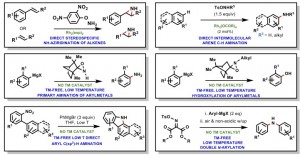
 18/04/2017
18/04/2017
 12:00
12:00
 ICIQ Auditorium
ICIQ Auditorium
- Lecturer: Prof. László Kürti
- University: Rice University, Houston (USA)
Practical Direct Electrophilic Amination of Olefins and Aromatic Systems
Amines and their derivatives are ubiquitous substances since they make up the overwhelming majority of drug molecules, agrochemicals as well as many compounds that are produced by plants and living organisms (i.e., natural products). Aromatic amines appear as substructures in more than one third of drug candidates while aziridines, in which the nitrogen atom is bridged between two carbon atoms, are high-reactive and versatile building blocks for a large variety of functionalized amines. Not surprisingly, organic chemists spend a considerable amount of their time with the synthesis and late-stage functionalization of amines that serve as key chemical building blocks for the preparation of biologically active compounds, especially in medicinal chemistry. There is an urgent need for the development of novel carbon-nitrogen bond-forming methods and reagents that expand the toolbox of synthetic organic chemists and enable the environmentally friendly construction of complex molecular structures using the fewest number of chemical steps and generating the least amount waste.
A highly attractive, but currently underdeveloped, approach is the utilization of weak bonds as a driving force to achieve the rapid formation of much stronger bonds under mild conditions. The Kürti lab has been exploring several fundamentally new strategies for the transition-metal-free direct: (i) primary amination of arylmetals such as aryl Grignard reagents and arylboronic acids; (ii) intramolecular C(sp2)-H amination of arenes; (iii) double arylation of a suitable nitrogen linchpin reagents to afford N,N-diarylamines. We have also discovered, in collaboration with the Falck (UTSW) and Ess labs (BYU), the Rh-catalyzed direct N-H/N-alkyl aziridination of olefins as well as the primary (-NH2) and NH-alkyl amination of arenes, transformations that eluded synthetic chemists for decades. These methods have one common feature: a weak N-O bond is cleaved in order to form a stronger C-N bond.
In-depth experimental and computational studies have already identified the critical factors required for efficient olefin NH– and N-alkyl aziridination as well as direct arene primary amination and led to the development of practical and chemoselec-tive aminating agents.
Other events

Let's create a brighter future
Join our team to work with renowned researchers, tackle groundbreaking
projects and contribute to meaningful scientific advancements




















